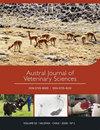从智利南部食品杂货店和市场获得的不同工业鸡蛋与非工业鸡蛋的物理质量
IF 0.5
4区 农林科学
Q3 VETERINARY SCIENCES
引用次数: 0
摘要
. 本研究的目的是确定工业(笼养和非笼养)和家庭农场鸡蛋的外部和内部质量参数,这些鸡蛋通常可以在智利等发展中国家的食品杂货店买到。通过两项试验来评价1)家庭农场和工业鸡蛋的质量差异;2)不同工业笼养和非笼养体系褐壳鸡蛋的质量差异。试验1共设5组,其中3组为工业鸡蛋:1)笼白壳鸡蛋,2)笼褐壳鸡蛋,3)笼褐壳无笼鸡蛋;其中两个是非工业化的:iv)家庭农场棕壳蛋和v)家庭农场蓝壳蛋。试验2共设4组,均为褐壳蛋:1)笼内褐壳蛋,2)非笼养褐壳蛋,3)南方散养褐壳蛋,4)中部散养褐壳蛋。两个试验均测定了蛋重、蛋长、蛋宽、蛋形指数、哈夫单位、蛋白比、蛋黄、蛋黄重和蛋白重、血斑和肉斑。在试验1中,棕色和蓝壳家庭农场鸡蛋的外观质量和内部质量相等,但有血斑,棕色鸡蛋的发生率更高。在实验2中,散养鸡蛋的蛋黄颜色比笼养鸡蛋的蛋黄颜色更强烈。在两个实验中,散养鸡蛋的蛋黄颜色都较深。综上所述,褐壳和蓝壳家庭农场鸡蛋除存在血斑外,内在质量基本相同,褐壳鸡蛋发生率较高。此外,南方散养鸡蛋的蛋壳质量较好,而散养鸡蛋的蛋黄颜色较浓,而电池鸡蛋的蛋黄颜色较浓。本文章由计算机程序翻译,如有差异,请以英文原文为准。
Physical quality of different industrial versus non-industrial eggs obtained from groceries and markets in southern Chile
. The aim of this study was to determine external and internal quality parameters of industrial (cages and cage-free) and family farms eggs that are normally available at groceries in developing countries such as Chile. Two experiments were performed to evaluate 1) quality differences between family farms and industrial eggs and 2) to determine quality differences between brown shell eggs from different industrial cage and cage-free systems. Experiment 1 consisted of five groups where three of them were industrial eggs: i) cage white shell eggs, ii) cage brown shell eggs, iii) brown shell cage-free eggs; and two of them were non-industrial: iv) family farm brown shell eggs and v) family farm blue shell eggs. Experiment 2 had four groups, all brown-shell types of eggs were used: i) cage brown eggs, ii) cage-free from aviary eggs, iii) southern free-range eggs and iv) central free-range eggs. In both Experiments, egg weight, egg length, egg width, egg shape index, Haugh units, albumen ratio, egg yolk, yolk weight and albumen weight, blood and meat spots were determined. In Experiment 1, brown and blue-shelled family farm eggs were equal in terms of external and internal quality, except for blood spots, with brown eggs having more incidence. In Experiment 2, free-range eggs presented more intense yolk colors compared to those from battery and cages. In both experiments, free-range eggs presented the darker yolk color. It can be concluded that brown and blue-shelled family farm eggs are equal in terms of external and internal quality, except for blood spots, with brown eggs having more incidence. In addition, free-range eggs from the southern part of the country presented better shell quality, whereas free-range eggs presented more intense yolk colors, while those of battery.
求助全文
通过发布文献求助,成功后即可免费获取论文全文。
去求助
来源期刊

Austral Journal of Veterinary Sciences
Veterinary-General Veterinary
CiteScore
1.60
自引率
0.00%
发文量
18
期刊介绍:
Austral Journal of Veterinary Sciences (formerly Archivos de Medicina Veterinaria) publishes original scientific contributions in English, containing the latest developments and discoveries in veterinary sciences. The journal covers topics such as animal health and production, preventive medicine, zoonosis, pharmacology and therapeutics, methods of diagnosis, and other areas related to the veterinary field.
Austral Journal of Veterinary Sciences aims to divulge information about advances in veterinary medicine among universities, research centres, industries, government agencies, biologists, agronomists and veterinarians.
 求助内容:
求助内容: 应助结果提醒方式:
应助结果提醒方式:


